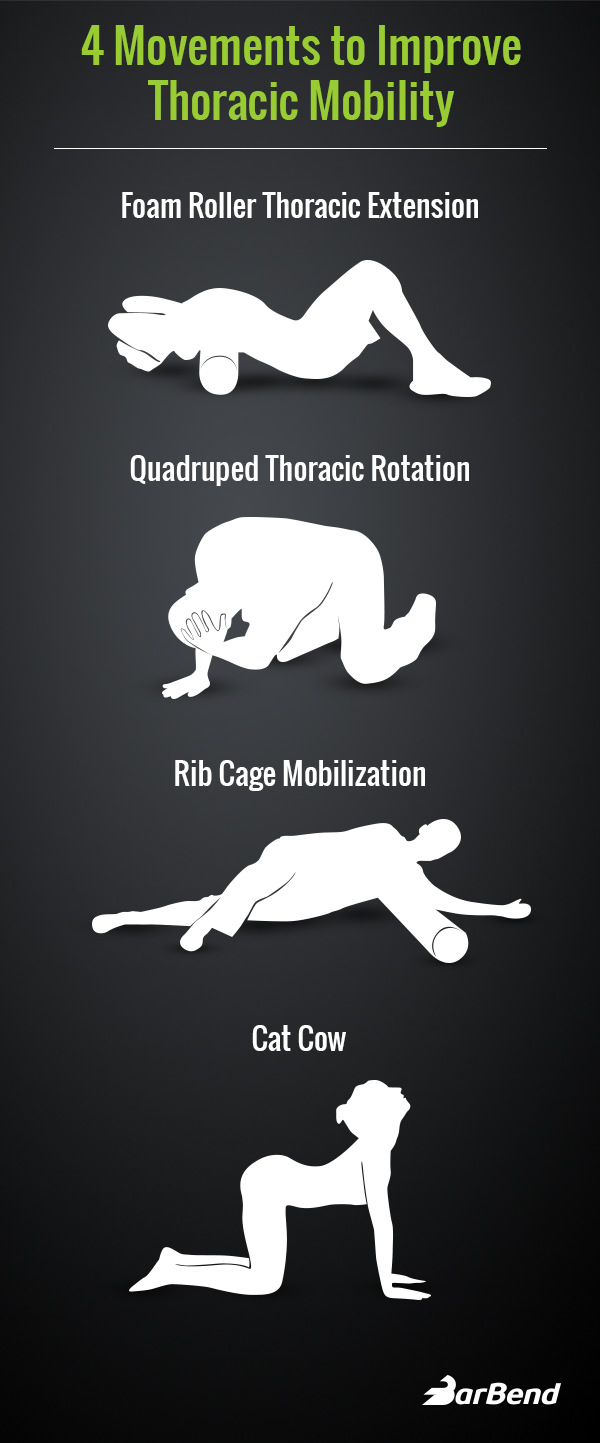The importance of thoracic spine mobility — the area of the spine that runs from the base of the neck to just beneath the rib cage — can easily be overlooked.
With low back pain being the most common form of back pain, a lot of attention is given to improving mobility and strength in the lumbar spine, situated between the rib cage and the pelvis.
And while lumbar spine health shouldn’t be ignored, the health and mobility of the thoracic spine is incredibly important for maintaining upright posture, ensuring proper form during squats and deadlifts, and efficiency with twisting and rotational movements.
Poor thoracic mobility can be hard to spot among the general population, but its symptoms include shoulder pain, low back pain, and a rounded and excessively stiff mid-upper back.
A strong core, strong back, and good posture will go a long way to improving your mobility. Here are some more tips that’ll help ensure a healthy, mobile thoracic spine.
Foam Roller Thoracic Extension Exercises
A big part of improving thoracic mobility is loosening the muscles that can become tight from sitting all day. For this outcome, it’s a good idea to regularly use a foam roller, lacrosse ball, or a peanut to mash the lats and the chest.
But it’s important to improve thoracic extension by allowing your spine to extend, and thoracic extension on a foam roller is an effective way to do so.
Lie on the ground, prop the foam roller under your thoracic spine, and extend your arms over your head. That’s the short version, but here’s Tony Gentilcore giving some slight form tweaks that you might find useful.
“People are very forward dominant because they sit at desks all day, but opening up and bending backwards in certain patterns can isolate different segments of the spine,” says Eugene Babenko, a doctor of physical therapy and head coach at Dubai’s CrossFit Gold Box. “I like using two lacrosse balls taped together, but putting a foam roller under the thoracic spine exerts pressure that’s less localized and less painful, so it allows you to really breathe.”
Rib Cage Mobilization
“It’s important to remember the thoracic spine is connected to the ribcage, so making sure you’re addressing the ribs on the side, the lats, the serratus, even the diaphragm underneath the rib cage is very important for loosening up,” says Babenko.
When you’re foam rolling, put the roller perpendicular to the body and rock back and forth (not up and down) to help mobilize the rib cage. A bonus is that it’s easy to combine rolling the rib cage and the lats at the same time.
Quadruped Thoracic Rotation
“That’s a good assessment as well as a good mobilization for loosening up the thoracic spine,” says Babenko.
Not everyone agrees on how perpendicular one’s thigh should be to the ground, with some performing the movement with the arms and legs straight up and down like a table, while others like to rock back so far that the butt and the heels are touching.
That’s sometimes called the rock-back quadruped extension-rotation, and it could make it a little easier to prevent the lumbar spine from becoming too involved in the movement. Try out both and see what works for you.
Cat Cow
A classic yoga pose, the goal here is to create a lot of flexion and extension throughout the spine, leading with the head. You might also find it helpful to synchronize breathing with the movement: inhale as you crane back, exhale as you crunch inward.
https://www.instagram.com/p/BSMjM8VB552/
The Takeaway
“It’s not just about making sure you’re doing twenty minutes of thoracic mobility before your workout,” says Babenko. “What about the eight other hours that are tightening it up? You’ve got to make sure you’re actively moving throughout the day.”
When it comes to thoracic mobility, warm-ups and strength training aren’t the whole story: be aware of your typing posture and break up periods of sitting every thirty minutes.
Featured image via @infinitefitnesspeninsula on Instagram.
